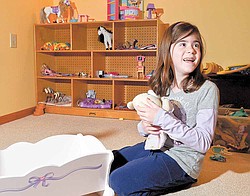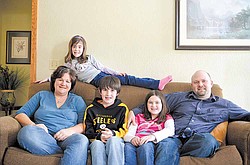Fetal surgery deemed a good option for treating spina bifida
The Vindicator (Youngstown)
Nicole Barber, a third-grader at Springfield Local Elementary School, plays with one of her favorite toys in her room at her New Middletown home. Nicole, born with spina bifida, was saved from symptoms of severe spina bifida by fetal surgery she and her mother, Lorie, underwent nine years ago.
The Vindicator (Youngstown)
Dan and Lorie Barber of New Middletown risked fetal surgery to repair the spine of their daughter, Nicole, in hopes of lessening the effects of her spina bifida. The Barber family, from left, Lorie, Nicole (lying across the back of the sofa); Zack, 12; Taylor, 10; and Dan. Nicole is a good reader and speller and last year ran the 50-yard dash in the Junior Olympics at her school.
Spina-bifida, a neural tube defect that occurs in the first month of pregnancy when the spinal column doesn’t close completely, is the most-
common, permanently disabling birth defect. Here are some facts about the condition:
An estimated 166,000 people in the United States are living with spina bifida.
Every day, an average of eight births are affected by spina
bifida or a similar birth defect of the brain and spine.
Each year, about 3,000 pregnancies are affected by these birth defects.
Up to 90 percent of children with the worst form of spina bifida have hydrocephalus (fluid on the brain) and must have surgery to insert a “shunt” that helps drain the fluid.
Other conditions include full or partial paralysis, difficulty with bladder- and bowel-control, learning disabilities, depression, latex allergy and social and sexual issues.
Source: Spina Bifida Association
NEW MIDDLETOWN
“I beat that spina bifida,” said 4-year-old Nicole Barber after her mother, Lorie, explained what a woman was doing with her child in a public restroom on a changing table.
The woman was using a catheter to help her child urinate, a side effect of spina bifida. Nicole does not require a catheter.
Nicole, now 9, continues, to a large degree, to beat spina bifida, a congenital condition in which part of the spinal cord protrudes through an opening in the spinal column while the fetus is in the mother’s womb.
The condition can lead to damage of the spinal cord and cause a number of debilitating side effects.
Some of the common side effects are incontinence; hydrocephalus, a buildup of fluid inside the skull commonly known as water on the brain that leads to brain swelling; lack of feeling in the feet and legs; and other developmental and learning disabilities.
Spina-bifida patients often need shunts inside their bodies to drain fluid from the brain to the abdomen. To urinate, they must insert a catheter (flexible tube) into their bladder.
The Barbers said Nicole’s pediatric urologist advised them to start using a catheter while Nicole was in diapers, saying it would be easier for the child to get used to it at an earlier age.
“We decided to wait until she was 3 and out of diapers to see if a catheter was necessary. It wasn’t, and that was one of my favorite days in all of this,” said Nicole’s father, Dan, a perfusionist at Forum Health Northside Medical Center and Trumbull Memorial Hospital. A perfusionist operates the heart-lung machine during heart operations.
Further proof that Nicole “beat” the condition is that, while she has mild hydrocephalus, she does not need a shunt.
As for learning disabilities, Nicole struggles with mathematics and has a tutor for the subject, Lorie said.
But, she is a good reader and came in third in the spelling bee in her second-grade class at Springfield Local Elementary School. She ran the 50-yard dash in the Junior Olympics at her school last year “and didn’t come in last,” said her mother with a smile; and she plays soccer and is a Girl Scout Brownie.
“She is my miracle,” said Lorie, former producer and now part-time assignment director at local TV stations WKBN and WYTV.
But Lorie’s miracle was not achieved without risk and anxiety.
It is a tremendous relief to Lorie and Dan that Nicole shows virtually no signs of spina bifida.
Nine years ago, Dan and Lorie, who have two other children, Zack, 12, and Taylor, 10, decided that Lorie would undergo pioneering maternal-fetal surgery at Vanderbilt University Medical Center in Tennessee to repair Nicole’s spine.
At the time, fetal surgery was not considered experimental, but neither was it commonplace, they said. Nicole’s surgery was just the 145th done at Vanderbilt, one of the pioneers of the surgery.
During the surgery, a Caesarean-like incision is used to reach the uterus. Then an incision is made in the uterus to provide the surgeon access to the fetus so the spinal cord can be placed back into the spinal canal and the tissue that covers stitched together.
The decision to have the fetal surgery was particularly difficult because, though spina bifida can have some serious side effects, it is not fatal. The maternal-fetal surgery, and its potential side effect, premature birth, can be.
“We risked Nicole’s life for a defect that wasn’t life-threatening to give her a better life,” Lorie said.
The Barbers feel their agonizing decision was vindicated earlier this month when the news broke that a seven-year National Institute of Health-funded trial — Management of Myelomeningocele Study (MOMS) — proved that there are benefits to fetal surgery in the treatment of spina bifida.
“We cried while we were reading the study on the computer,” Dan said.
The outcome of their decision to have the surgery is positive, but the path to recovery for Nicole has not been easy.
One of the possible side effects of the surgery is premature birth, and even though Lorie took medications to prevent contractions, she underwent a second C-section operation two weeks after the fetal surgery to bring 1-pound, 10-ounce Nicole into the world Feb. 5, 2002.
“I could hold her in my hand,” her father said.
Nicole spent 103 days in Forum Health Tod Children’s Hospital, coming home just three days shy of her projected birth date. She had years of physical and occupational therapy. She walked at 22 months, and attended the Mahoning County Board of Developmental Disabilities’ Leonard Kirtz School for about 18 months until she was 3. There is still concern the hydrocephalus could become worse, Dan said.
“We told our story initially in 2002 to make other women and even doctors aware of the fetal-surgery option in addition to post-birth surgery and abortion,” Lorie said.
“My goal, as it was when The Vindicator interviewed my family nine years ago, is to spread the word to women pregnant with a child with spina bifida that abortion and post-surgery are not the only choices. There is a third choice, and now the medical experts agree that fetal surgery is a good choice,” she added.
 43
43


